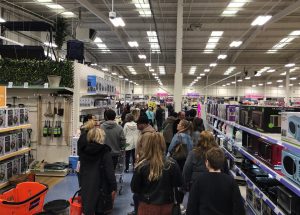 Steve Collinge, Managing Director of Insight Retail Group Ltd and Executive Editor of Insight DIY comments on the rise of ‘discounters’ since their introduction into Ireland during the recession.
Steve Collinge, Managing Director of Insight Retail Group Ltd and Executive Editor of Insight DIY comments on the rise of ‘discounters’ since their introduction into Ireland during the recession.
Irish consumers have long memories and having been scarred by the events of ten years ago, they remain understandably reluctant to spend more than they have to. This applies to many product categories, from food to furniture, housewares to clothing and it applies to home improvement and gardening.
As consumers become hooked on searching for a good deal and with the ease of comparing prices online, retail brand loyalty has all but vanished. New companies have appeared from nowhere and are already challenging the domination of retailers who have been operating in Ireland for decades.
The ‘search for value’ is the key reason why Discounting has been a consistent feature of the Irish grocery market for the last ten years, with Aldi and Lidl driving food retail prices in some cases back to 1999 levels. Today, Aldi is Ireland’s fastest-growing supermarket, with a 10.8% share, placing it in fourth spot out of the five major supermarket chains, behind Dunnes, Tesco and Supervalu and just ahead of Lidl. This year they intend to open a further seven new branches, to add to their existing estate of 129 locations and hire more than 500 new staff. So, what does this mean for the Home Improvement industry? Should we fear a similar onset of discounters driving down the retail prices of the everyday brands that are so critical to the positive recovery we’ve experienced in recent years?
If you’re a retailer selling predominantly to Irish consumers purchasing products for their  own home, then the answer is definitely yes, you should be concerned, and you should
own home, then the answer is definitely yes, you should be concerned, and you should
be taking action now to ensure that the discounters don’t get hold. If you’re a trade business, the retailers I’ll focus on in the rest of this article are unlikely to impact your
business, but with Screwfix already on their way, I think you may already have enough to worry about. In the UK, the ‘discounter’ or ‘variety’ store retailers have a long history, but for many years were seen simply as down-market operators, selling poor quality products to a cash-strapped segment of less-well-off consumers. Their credibility was poor and as a result, their growth was stunted. However, as in Ireland, the economic crash hit hard and consumers were forced to search for value, to seek out products and services they could afford.
As in Ireland, UK consumers have embraced the food discounters and according to Kantar Worldpanel, Aldi and Lidl now account for more than 13% of the UK grocery market and last year, a staggering two thirds of all UK households visited a discounter over the Christmas period. In general merchandise three retailers in particular; B&M Bargains, The Range and Home Bargains have established Discounters as a major force in UK retailing. They’ve focused on investing in their stores, they’ve improved their category management, product availability and begun stocking the well-known brands. This gave them much needed credibility and when combined with prices 20%-50% below the existing general merchandise or home improvement retailers, their growth accelerated. Today, the combined store estate of the six leading discounters in the UK (excluding Aldi and Lidl) stands at more than 3,000 outlets and in the last five years alone, almost 100 of these are stores have been acquired from closing B&Q and Homebase branches.
In Ireland, the situation is remarkably similar. A number of discounters have existed for many years, but it’s only since 2010 that the new breed of more credible, brand focused variety stores have appeared, selling well-known products to consumers at significant savings.
 There are numerous examples I could provide from Dealz, with 63 Irish stores, to Mr. Price with 45 branches up and down the country, but the one I wanted to highlight today is The Range. The company was started by the current owner Chris Dawson as an open-air market stall in Plymouth in 1980 and it wasn’t until 1989 that he opened his first physical store. Today the company operates from 155 stores in the UK and seven in Ireland. Their first outlet opened in August 2016 in a former Atlantic Homecare unit in Limerick. The second opened in Cork in January 2017, Carlow store opened in a former Homebase unit in August 2017 and their most recent store opening was in Northside, Dublin, in July 2018. Whilst in Dublin at the beginning of April, I spent time in the Liffey Valley store which opened in May 2017. They offer an eclectic mix of everything for the home from housewares and furniture to gardening, from pet-care to stationery, from clothing to paint. Brands dominate and are used very effectively to drive footfall. This broad range of categories leads to a huge stock-holding, in some cases, as many as 60,000 individual products are ranged in a single store. On the day I visited, the store was busy and it’s clear that the Irish consumer is taking well to the interesting mix of products and the attractive prices. The don’t just dump products on the shelves, look at the effort they’ve put in to inspire customers with their paint and wallpaper. This is not an unusual example, store staff are encouraged to provide engaging and interesting displays which in some cases are at least as good as the displays I’ve seen in Woodie’s, Homebase and B&Q.
There are numerous examples I could provide from Dealz, with 63 Irish stores, to Mr. Price with 45 branches up and down the country, but the one I wanted to highlight today is The Range. The company was started by the current owner Chris Dawson as an open-air market stall in Plymouth in 1980 and it wasn’t until 1989 that he opened his first physical store. Today the company operates from 155 stores in the UK and seven in Ireland. Their first outlet opened in August 2016 in a former Atlantic Homecare unit in Limerick. The second opened in Cork in January 2017, Carlow store opened in a former Homebase unit in August 2017 and their most recent store opening was in Northside, Dublin, in July 2018. Whilst in Dublin at the beginning of April, I spent time in the Liffey Valley store which opened in May 2017. They offer an eclectic mix of everything for the home from housewares and furniture to gardening, from pet-care to stationery, from clothing to paint. Brands dominate and are used very effectively to drive footfall. This broad range of categories leads to a huge stock-holding, in some cases, as many as 60,000 individual products are ranged in a single store. On the day I visited, the store was busy and it’s clear that the Irish consumer is taking well to the interesting mix of products and the attractive prices. The don’t just dump products on the shelves, look at the effort they’ve put in to inspire customers with their paint and wallpaper. This is not an unusual example, store staff are encouraged to provide engaging and interesting displays which in some cases are at least as good as the displays I’ve seen in Woodie’s, Homebase and B&Q.
Slipping ‘underneath the radar’ is what The Range do best. They are a formidable force in retailing, a company that seems to have found the perfect mix of brands, credibility and prices that has consumers flocking to their stores in increasing numbers. From the financial data posted to Companies House, The Range (Ireland) Limited for the year ended 28th January 2018, showed a turnover of €28.4m, up from just €6.5m the year before. In terms of profit, for 2018 this leapt to a shade under €7m, up from €1.1m in 2017.
The new breed of discounters are here to stay. They’ve identified that the Irish consumer still wants value, but they don’t want poor quality products, they want the brands they know and love, but at prices they can afford.












